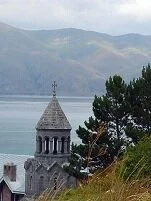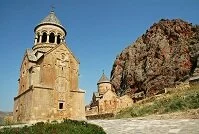Architecture of Armenia

Church in Sevan
Much of Armenia's most notable architecture is either historic church architecture or more recent soviet architecture. As the first country in the world to make Christianity its official religion, Armenia also has some of, if not the oldest still used churches in the world.

Noravank Monastery
The Cathedral of Echmiadzin was first built in 301-303 and remains to this day as the head of the Armenian Orthodox Church. Since it was originally built, the church has undergone a number of renovations, particularly in the 400s, 600s, and 1600s. Since it was built, the style has influenced many churches in Armenia, Georgia, and even other Eastern Orthodox churches which later arose in Byzantium.
Church architecture continued to develop in Armenia and the Medieval Ages experienced rock shrewn churches, with the Monastery of Geghard acting as the best example. The historic heart of what can be seen today was built in the 1200s as it was carved out of the adjoining cliff.